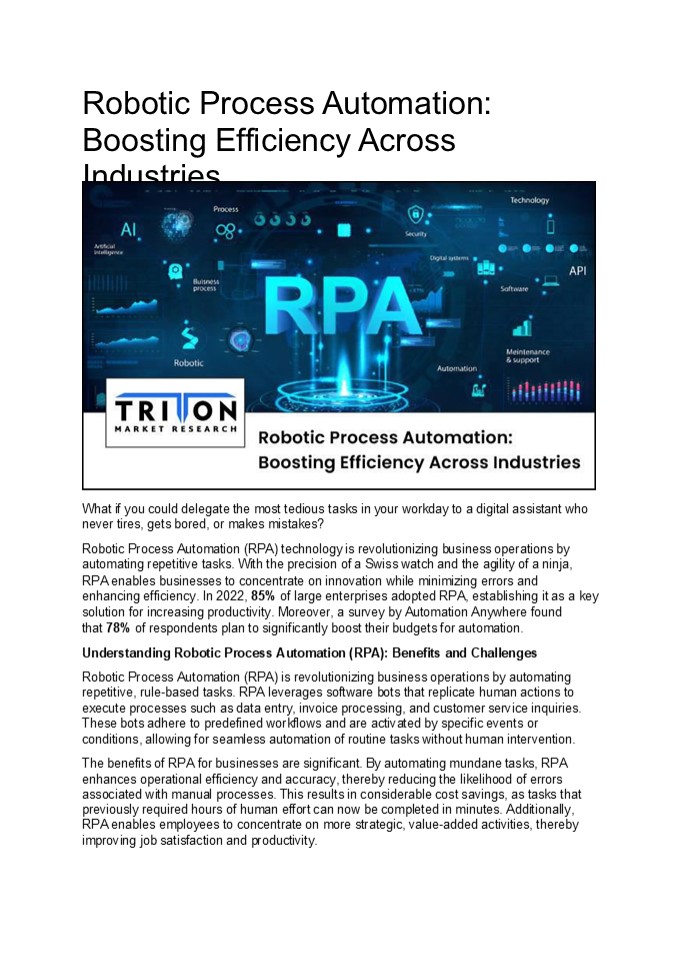Robotic Process Automation: Boosting Efficiency Across Industries - PowerPoint PPT Presentation
Title:
Robotic Process Automation: Boosting Efficiency Across Industries
Description:
Robotic Process Automation (RPA) technology is revolutionizing business operations by automating repetitive tasks. Read more & get more insights into our blog – PowerPoint PPT presentation
Number of Views:0
Title: Robotic Process Automation: Boosting Efficiency Across Industries
1
Robotic Process Automation Boosting Efficiency
Across Industries
What if you could delegate the most tedious tasks
in your workday to a digital assistant who never
tires, gets bored, or makes mistakes? Robotic
Process Automation (RPA) technology is
revolutionizing business operations by automating
repetitive tasks. With the precision of a Swiss
watch and the agility of a ninja, RPA enables
businesses to concentrate on innovation while
minimizing errors and enhancing efficiency. In
2022, 85 of large enterprises adopted RPA,
establishing it as a key solution for increasing
productivity. Moreover, a survey by Automation
Anywhere found that 78 of respondents plan to
significantly boost their budgets for
automation. Understanding Robotic Process
Automation (RPA) Benefits and Challenges Robotic
Process Automation (RPA) is revolutionizing
business operations by automating repetitive,
rule-based tasks. RPA leverages software bots
that replicate human actions to execute processes
such as data entry, invoice processing, and
customer service inquiries. These bots adhere to
predefined workflows and are activated by
specific events or conditions, allowing for
seamless automation of routine tasks without
human intervention. The benefits of RPA for
businesses are significant. By automating mundane
tasks, RPA enhances operational efficiency and
accuracy, thereby reducing the likelihood of
errors associated with manual processes. This
results in considerable cost savings, as tasks
that previously required hours of human effort
can now be completed in minutes. Additionally,
RPA enables employees to concentrate on more
strategic, value-added activities, thereby
improving job satisfaction and productivity.
2
- However, adopting RPA presents challenges,
including resistance to change, integration
issues with existing systems, and the need for
ongoing maintenance. To overcome these
challenges, organizations should emphasize clear
communication about the benefits of RPA, offer
comprehensive training, and choose scalable,
flexible RPA solutions that integrate seamlessly
with their current technology infrastructure. - Having explored what Robotic Process Automation
(RPA) is and its benefits, lets now examine how
this technology is being utilized across various
industries to drive efficiency and accuracy. - Real-World Applications of Robotic Process
Automation (RPA) - RPA in Finance Enhancing Accuracy and Fraud
Prevention - RPA is transforming the finance industry by
automating complex, data-intensive tasks. It
plays a critical role in reconciling bank
statements, automating loan processing, and
significantly reducing the risk of human error.
Additionally, RPA supports fraud detection and
prevention by continuously monitoring
transactions for suspicious activities. In
customer onboarding and Know Your Customer (KYC)
verification, RPA ensures regulatory compliance
while expediting the process. - For example, KeyBank, a regional American bank,
adopted RPA early to boost efficiency and
accuracy in its operations. RPA in banking
automates processes like invoice management,
purchase orders, and accounts receivable,
allowing KeyBank to streamline payments and
deliver smoother, error-free transactions at
every stage. - RPA in Healthcare Improving Patient Care and
Operational Efficiency - RPA in healthcare is making significant strides
by improving both patient care and administrative
efficiency. Automating patient data entry and
management ensures accurate records with minimal
manual intervention. RPA also optimizes
appointment scheduling and reminders, reducing
no-shows and enhancing clinic management.
Additionally, it streamlines medical records
management, ensuring that patient information is
always up-to-date and easily accessible. - A UK-based startup, T-Systems, is utilizing RPA
to develop healthcare solutions, including a
system for tracking the time and location of
organs during transplant operations. Similarly,
India-based Feat Systems offers an RPA-enabled
web app that automates appointment creation,
reminders, and cancellations, making the process
more accessible and efficient for users. - RPA in Customer Service Revolutionizing Response
Times and Experience - RPA is transforming customer service by
automating repetitive tasks, improving response
times, and ensuring that customer inquiries are
handled efficiently. Automated customer service
processes such as ticket routing, order
processing, and fulfillment are accelerated,
resulting in faster delivery times and an
enhanced customer experience. RPA-powered
chatbots offer 24/7 support, addressing routine
inquiries and escalating more complex issues to
human agents. - For instance, Vaasan Sähkö Group leverages
automation to enhance customer communication,
leading to improved satisfaction. Sisua Digital
implemented the Kyösti robot for Y-Foundation to
boost customer service operations and deliver
swift, reliable support. - RPA in Human Resources Streamlining Employee
Management
3
In human resources, RPA is transforming
traditionally manual and time-consuming tasks
such as employee onboarding and offboarding.
Automation ensures consistency and compliance
with company policies while assisting with time
and attendance management by providing accurate
tracking and reporting. Romanian startup Aggranda
specializes in creating intelligent automation
solutions for HR companies. It automates routine
tasks like data entry, payroll management, and
time tracking, significantly reducing manual
effort and streamlining HR processes. Whats Next
for Robotic Process Automation? Robotic Process
Automation (RPA) is evolving rapidly, especially
when integrated with artificial intelligence
(AI). By automating repetitive tasks, RPA allows
employees to shift their focus to more strategic,
creative, and value-driven activities, fostering
a more engaged and productive workforce. Industry
projections suggest that by 2030, AI-powered
automation technologies could replace up to 30
of work hours in the United States. The future of
RPA looks bright, with advancements such as
cognitive automation, machine learning
integration, and cloud-based RPA solutions on the
horizon. These innovations will further transform
business operations, offering greater
scalability, flexibility, and efficiency, setting
the stage for a new era of automation.































